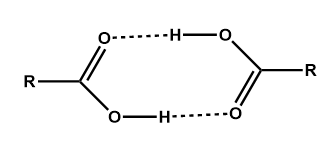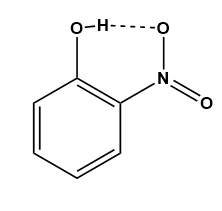
Which contains hydrogen bonds?
(a) \[HF\]
(b) \[HCl\]
(c) \[HBr\] \[\]
(d) \[HI\]
Answer
222.3k+ views
Hint: The hydrogen bond is formed between more electronegative elements and hydrogen atoms such as fluorine, oxygen, nitrogen, etc.,
Complete Step by Step Solution:
When a hydrogen atom is connected to highly electronegative elements then the formation of a hydrogen bond occurs. During the formation of hydrogen bonds, the electronegative atom has a partial negative charge whereas the hydrogen atom possesses a partial positive charge.
The main reason for the hydrogen bond is dipole-dipole interaction.
Type of hydrogen bond
Intermolecular hydrogen bond
When the hydrogen bond exists between two molecules is called an intermolecular hydrogen bond. Such a type of hydrogen bond is found in a carboxylic acid (Image 1).

Image: Intermolecular hydrogen bond in a carboxylic acid.
Intramolecular hydrogen bond: When the formation of a hydrogen bond occurs in the same molecule then it is called an intramolecular hydrogen bond. Such a type of hydrogen bonding can be seen in nitro phenol (Image 2).

Image: Intramolecular hydrogen bond in nitrophenol.
As to the definition hydrogen bond is formed between the hydrogen atom and a more electronegative atom. Therefore, in the question, the fluorine atom is more electronegative than chlorine, bromine, and iodine. Hence the \[HF\] will contain a hydrogen bond.
Note: The hydrogen bond also increases the melting and boiling points of the compounds. The hydrogen bond also increases the solubility of compounds. The hydrogen bonding also increases the viscosity of the compounds. Hydrogen bonding is also present in nucleic acids. Which helps to bind two strands together. The folding in protein is arise due to hydrogen bonding.
Complete Step by Step Solution:
When a hydrogen atom is connected to highly electronegative elements then the formation of a hydrogen bond occurs. During the formation of hydrogen bonds, the electronegative atom has a partial negative charge whereas the hydrogen atom possesses a partial positive charge.
The main reason for the hydrogen bond is dipole-dipole interaction.
Type of hydrogen bond
Intermolecular hydrogen bond
When the hydrogen bond exists between two molecules is called an intermolecular hydrogen bond. Such a type of hydrogen bond is found in a carboxylic acid (Image 1).

Image: Intermolecular hydrogen bond in a carboxylic acid.
Intramolecular hydrogen bond: When the formation of a hydrogen bond occurs in the same molecule then it is called an intramolecular hydrogen bond. Such a type of hydrogen bonding can be seen in nitro phenol (Image 2).

Image: Intramolecular hydrogen bond in nitrophenol.
As to the definition hydrogen bond is formed between the hydrogen atom and a more electronegative atom. Therefore, in the question, the fluorine atom is more electronegative than chlorine, bromine, and iodine. Hence the \[HF\] will contain a hydrogen bond.
Note: The hydrogen bond also increases the melting and boiling points of the compounds. The hydrogen bond also increases the solubility of compounds. The hydrogen bonding also increases the viscosity of the compounds. Hydrogen bonding is also present in nucleic acids. Which helps to bind two strands together. The folding in protein is arise due to hydrogen bonding.
Recently Updated Pages
Types of Solutions in Chemistry: Explained Simply

States of Matter Chapter For JEE Main Chemistry

Difference Between Alcohol and Phenol: Structure, Tests & Uses

Conduction Explained: Definition, Examples & Science for Students

Balancing of Redox Reactions - Important Concepts and Tips for JEE

Atomic Size - Important Concepts and Tips for JEE

Trending doubts
JEE Main 2026: Application Form Open, Exam Dates, Syllabus, Eligibility & Question Papers

Derivation of Equation of Trajectory Explained for Students

Hybridisation in Chemistry – Concept, Types & Applications

Understanding the Angle of Deviation in a Prism

How to Convert a Galvanometer into an Ammeter or Voltmeter

Degree of Dissociation: Meaning, Formula, Calculation & Uses

Other Pages
Solutions Class 12 Chemistry Chapter 1 CBSE Notes - 2025-26

NCERT Solutions For Class 12 Chemistry Chapter 1 Solutions - 2025-26

The D and F Block Elements Class 12 Chemistry Chapter 4 CBSE Notes - 2025-26

NCERT Solutions for Class 12 Chemistry Chapter Chapter 7 Alcohol Phenol and Ether

NCERT Solutions ForClass 12 Chemistry Chapter Chapter 8 Aldehydes Ketones And Carboxylic Acids

JEE Advanced Marks vs Ranks 2025: Understanding Category-wise Qualifying Marks and Previous Year Cut-offs




